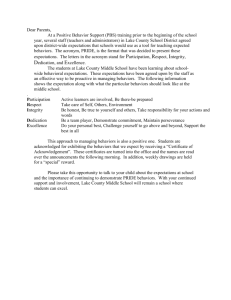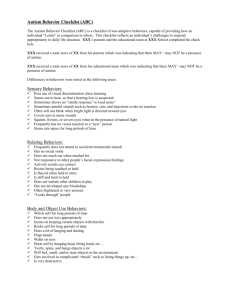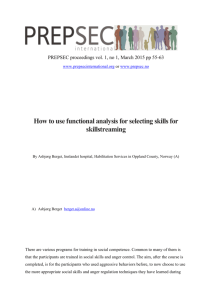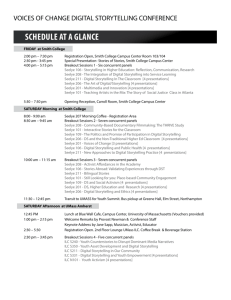Conceptualizing Culture -- Text only
advertisement
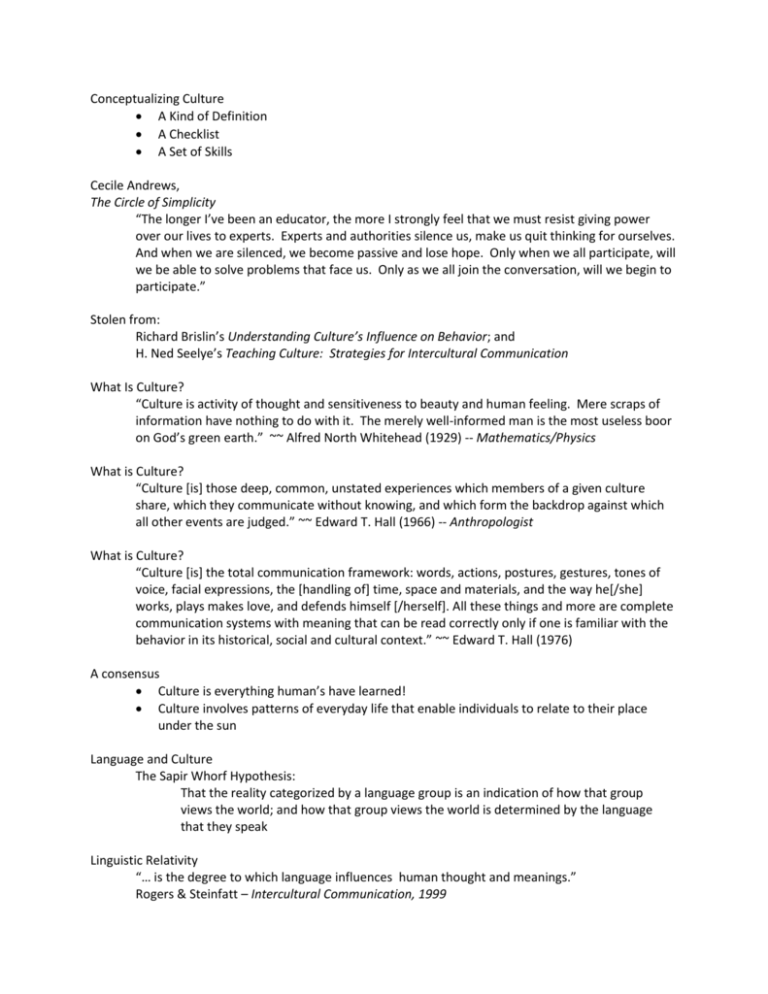
Conceptualizing Culture A Kind of Definition A Checklist A Set of Skills Cecile Andrews, The Circle of Simplicity “The longer I’ve been an educator, the more I strongly feel that we must resist giving power over our lives to experts. Experts and authorities silence us, make us quit thinking for ourselves. And when we are silenced, we become passive and lose hope. Only when we all participate, will we be able to solve problems that face us. Only as we all join the conversation, will we begin to participate.” Stolen from: Richard Brislin’s Understanding Culture’s Influence on Behavior; and H. Ned Seelye’s Teaching Culture: Strategies for Intercultural Communication What Is Culture? “Culture is activity of thought and sensitiveness to beauty and human feeling. Mere scraps of information have nothing to do with it. The merely well-informed man is the most useless boor on God’s green earth.” ~~ Alfred North Whitehead (1929) -- Mathematics/Physics What is Culture? “Culture [is] those deep, common, unstated experiences which members of a given culture share, which they communicate without knowing, and which form the backdrop against which all other events are judged.” ~~ Edward T. Hall (1966) -- Anthropologist What is Culture? “Culture [is] the total communication framework: words, actions, postures, gestures, tones of voice, facial expressions, the [handling of] time, space and materials, and the way he[/she] works, plays makes love, and defends himself [/herself]. All these things and more are complete communication systems with meaning that can be read correctly only if one is familiar with the behavior in its historical, social and cultural context.” ~~ Edward T. Hall (1976) A consensus Culture is everything human’s have learned! Culture involves patterns of everyday life that enable individuals to relate to their place under the sun Language and Culture The Sapir Whorf Hypothesis: That the reality categorized by a language group is an indication of how that group views the world; and how that group views the world is determined by the language that they speak Linguistic Relativity “… is the degree to which language influences human thought and meanings.” Rogers & Steinfatt – Intercultural Communication, 1999 Metacommunication Communication about communication Recognizing when your “response” has been pre-determined “Do you need help finding anything?” From the cashier when you’re in the middle of checking out! Language and Culture Language and culture – so intertwined, how can you expect to really learn one without the other? Learning a language in isolation of its cultural roots prevents one from becoming socialized into its contextual use. Language and Culture Knowledge of linguistic structure alone does not carry with it any special insight into the political, social, religious or economic system. Or even insight into when you should shut your mouth. Influence of culture A major difficulty in discussions of culture is that people rarely have the opportunity to examine the influence of their own cultural background on their behavior Culture: an Amorphous Concept Often, the concepts culture and cultural differences are used in ways that may not be very helpful. The danger in the frequent use of the term “culture” is that it contains so much information about values, ideals, concepts, and expected behaviors that the term is not terribly useful in analyzing any one specific aspect. Culture: an Amorphous Concept It is the specific aspects of culture that are helpful in analyzing human behavior. A 12 pt. Checklist from Brislin Because it’s so hard to define culture, it’s perhaps more helpful to use a checklist to help make a decision about whether something is part of one’s culture or not. 1. Assumptions About Life Culture consists of ideals, values and assumptions about life that are widely shared among people and that guide specific behaviors. Assumptions and values are stored in people’s minds and can be called upon when necessary for their usefulness in guiding specific behaviors. 2. The Person-Made Part of the Environment Another key aspect of culture is that it is created by people. People’s responses to the environment that surrounds them are part of their culture. 3. Transmission Generation to Generation Cultural values exist for long periods of time in a society. They cannot be introduced quickly. If there are values considered central to a society that have existed for many years, they must be transmitted from one generation to another. 3. Transmission from Generation to Generation Children must learn the values from various elders who have the responsibility to make sure that the children grow up to be acceptable members of the community. 4. Experiences during Childhood So, there will be childhood experiences that lead to the learning and eventual internalization of the values. In other words, if a value is cultural, people should be able to think of experiences during childhood that helped them to learn that value. 5. Culture Is Not Widely Discussed Aspects of one’s culture are not frequently discussed by adults in the same culture. Since culture is widely shared and accepted, there is little reason to discuss it frequently. Thus, people have very little practice discussing culture. 6. Well-Meaning Clashes Culture can become clearest in well-meaning clashes. This term describes encounters in which people are behaving properly and in a socially skilled manner according to the norms in their own culture. No one is trying to be difficult or unpleasant. 7. Fill in the Blanks Culture allows people to “fill in the blanks” when presented with a basic sketch of familiar behaviors. Jokes are difficult because they often include 2 categories coming together and getting “twisted” into one another. Jay Leno – an Ooooold Joke “There was a rat discovered living in the basement of the United States Senate. However, the senators won’t be bringing in an exterminator because they always look after their own.” 8. Cultural Values Remain Cultural values remain despite compromises and slip-ups. Even though people can list exceptions, the cultural value is seen as a constant that continues to guide specific behaviors. 9. Emotional Reactions There are emotional reactions when cultural values are violated or when a culture’s expected behaviors are ignored. 10. Acceptance and Rejection There can be acceptance and rejection of a culture’s values at different times in a person’s life. Common examples involve rebellious adolescents and young adults who accept a culture’s expectation after having children of their own. 11. Difficulty of Fast Change When changes in cultural values are contemplated, the reaction that “this will be difficult and time consuming” is likely. This reaction will apply both to existing cultural values that might be changed or existing values that we may want to become part of our culture. 12. Summarizable in Sharp Contrasts When comparing proper and expected behavior across cultures, some observations are summarizable in sharp contrasts. Examples are the treatment of time, spatial orientations people adopt, and the clarity of the rules and norms for certain complex behaviors. (low vs. high context ) Seelye’s 6 Skills These skills nurture and support intercultural communication You get “data” and these skills help you to deal with it Underpinning all the skills is one basic act: personal interaction with someone from a different culture. #1 Interest Cultivating curiosity about another culture (or another segment or subculture of one’s own culture) and empathy toward its members #2 Who Recognizing that role expectations and other social variables such as age, sex, social class, religion, ethnicity, and place of residence affect the way people speak and behave #3 What Realizing that effective communication requires discovering the culturally conditioned images that are evoked in the minds of people when they think, act, and react to the world around them #4 Where and When Recognizing that situational variables and convention shape behavior in important ways #5 Why Understanding that people generally act the way they do because they are using options that their society allows for satisfying basic physical and psychological needs, and that cultural patterns are interrelated and tend to support need satisfaction mutually #6 Exploration Developing the ability to evaluate the strength of a generalization about the target culture (from the evidence substantiating it), and to locate and organize information about the target culture from the library, the mass media, people and personal observation




